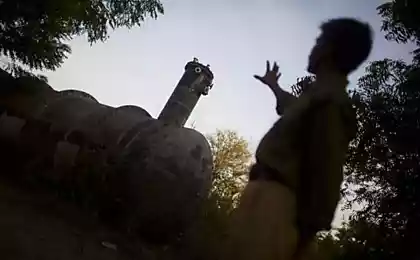203
The mystery of the Iron Column in Delhi
The mysterious iron column in Delhi is striking not only for its age (over 1500 years), but also for its resistance to corrosion, which modern metal production technologies will envy.
According to Professor A. P. Gupta, Head of the Department of Applied and Humanities at the Institute of Technology and Management in India, one of the main attractions of Delhi reaches 7 meters in height and is 99.72% iron.
To date, wrought iron is produced with a purity of about 99-99.8%, but it contains impurities of manganese and sulfur, which were not found in the iron column. In addition, the ancient pillar is covered with a protective oxide film, which fundamentally distinguishes the technology of its manufacture from everything that is currently produced.
Even during the monsoon period, the column managed to survive, and it does not have the slightest trace of rust. The inscriptions on the pillar date back to about 400 AD, but at that time it was common to erect old columns with new inscriptions containing, for example, announcements of victory in battle or other all sorts of triumphs.
It is also known that such a pillar could only be made 400 years ago, when foundries learned to master such techniques for the manufacture of iron structures.
Another mysterious monument of antiquity is a statue of Buddha from Sultanganganga, cast from pure copper and weighing more than a ton. According to scientists, this statue is at least 1,500 years old and, until now, there is no scientific explanation for how the ancient Indian blacksmiths were able to make such a work of art.
Now the statue of the copper Buddha is in the Birmingham Museum and Art Gallery, and a sign with its description reads: “The statue of the Buddha, which is about 1,500 years old, has survived virtually intact, making it a unique landmark in the world.”
source
Source: /users/155
According to Professor A. P. Gupta, Head of the Department of Applied and Humanities at the Institute of Technology and Management in India, one of the main attractions of Delhi reaches 7 meters in height and is 99.72% iron.
To date, wrought iron is produced with a purity of about 99-99.8%, but it contains impurities of manganese and sulfur, which were not found in the iron column. In addition, the ancient pillar is covered with a protective oxide film, which fundamentally distinguishes the technology of its manufacture from everything that is currently produced.
Even during the monsoon period, the column managed to survive, and it does not have the slightest trace of rust. The inscriptions on the pillar date back to about 400 AD, but at that time it was common to erect old columns with new inscriptions containing, for example, announcements of victory in battle or other all sorts of triumphs.
It is also known that such a pillar could only be made 400 years ago, when foundries learned to master such techniques for the manufacture of iron structures.
Another mysterious monument of antiquity is a statue of Buddha from Sultanganganga, cast from pure copper and weighing more than a ton. According to scientists, this statue is at least 1,500 years old and, until now, there is no scientific explanation for how the ancient Indian blacksmiths were able to make such a work of art.
Now the statue of the copper Buddha is in the Birmingham Museum and Art Gallery, and a sign with its description reads: “The statue of the Buddha, which is about 1,500 years old, has survived virtually intact, making it a unique landmark in the world.”
source
Source: /users/155






















